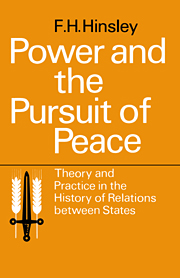Book contents
- Frontmatter
- Contents
- INTRODUCTION
- PART I A HISTORY OF INTERNATIONALIST THEORIES
- PART II A HISTORY OF THE MODERN STATES' SYSTEM TO 1900
- PART III INTERNATIONAL RELATIONS AND INTERNATIONAL ORGANIZATIONS IN THE TWENTIETH CENTURY
- 12 International Relations in the First Half of the Twentieth Century
- 13 The First World War
- 14 The Failure of the League of Nations
- 15 The Causes of the Second World War
- 16 The Nature and Development of the United Nations
- 17 International Relations since the Second World War
- References
- Index
17 - International Relations since the Second World War
Published online by Cambridge University Press: 11 January 2010
- Frontmatter
- Contents
- INTRODUCTION
- PART I A HISTORY OF INTERNATIONALIST THEORIES
- PART II A HISTORY OF THE MODERN STATES' SYSTEM TO 1900
- PART III INTERNATIONAL RELATIONS AND INTERNATIONAL ORGANIZATIONS IN THE TWENTIETH CENTURY
- 12 International Relations in the First Half of the Twentieth Century
- 13 The First World War
- 14 The Failure of the League of Nations
- 15 The Causes of the Second World War
- 16 The Nature and Development of the United Nations
- 17 International Relations since the Second World War
- References
- Index
Summary
Close students of international affairs are beginning to recognise that, at some point since the second World War, the relations between the major Powers have altered in quality from what they were like between the wars, and are now in a state of ‘deadlock’ which renders large-scale war unlikely for a considerable time to come. Mr C. M. Woodhouse is one of these. In his book on British foreign policy since the second World War he assumes that the deadlock began to emerge in the middle of the 1950's, that it resulted from the achievement at that time of nuclear parity by the two sides in the Great Power struggle and that, so far as major wars are concerned, it ‘might well mean permanent peace’. These conclusions are so nearly correct, and yet so little assimilated by the public mind, that the faults committed by Mr Woodhouse in the course of reaching them might normally have been left for specialists to discover. To lay these faults bare, however, is to strengthen the conclusions, and since so many people remain sceptical at such optimism there can be no objection to making the effort to do this.
The first thing to be said is that Mr Woodhouse is wrong in tracing back the deadlock only to the middle of the 1950's, and he is wrong because he confuses the time when it became a fact with the time when the fact was at last beginning to be recognised.
- Type
- Chapter
- Information
- Power and the Pursuit of Peace: Theory and Practice in the History of Relations Between States , pp. 346 - 367Publisher: Cambridge University PressPrint publication year: 1962



